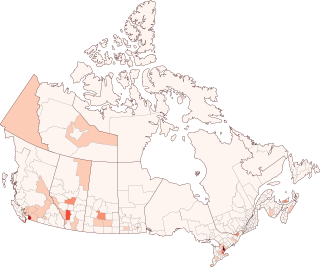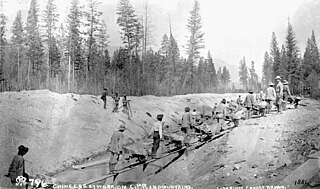Related Research Articles

The Chinese Exclusion Act was a United States federal law signed by President Chester A. Arthur on May 6, 1882, prohibiting all immigration of Chinese laborers for 10 years. The law made exceptions for merchants, teachers, students, travelers, and diplomats. The Chinese Exclusion Act was the first and only major U.S. law ever implemented to prevent all members of a specific national group from immigrating to the United States.
The Gentlemen's Agreement of 1907 was an informal agreement between the United States of America and the Empire of Japan whereby Japan would not allow further emigration to the United States and the United States would not impose restrictions on Japanese immigrants already present in the country. The goal was to reduce tensions between the two Pacific nations such as those that followed the Pacific Coast race riots of 1907 and the segregation of Japanese students in public schools. The agreement was not a treaty and so was not voted on by the United States Congress. It was superseded by the Immigration Act of 1924.

Chinese Canadians are Canadians of full or partial Chinese ancestry, which includes both naturalized Chinese immigrants and Canadian-born Chinese. They comprise a subgroup of East Asian Canadians which is a further subgroup of Asian Canadians. Demographic research tends to include immigrants from Mainland China, Taiwan, Hong Kong, and Macau, as well as overseas Chinese who have immigrated from Southeast Asia and South America into the broadly defined Chinese Canadian category.
The Chinese Immigration Act, 1923, also known as the "Chinese Exclusion Act", was a Canadian Act of Parliament passed by the government of Liberal Prime Minister William Lyon Mackenzie King, banning most forms of Chinese immigration to Canada. Immigration from most countries was controlled or restricted in some way, but only the Chinese were completely prohibited from immigrating to Canada.
The Asiatic Exclusion League was an organization formed in the early 20th century in the United States and Canada that aimed to prevent immigration of people of Asian origin.

The Geary Act was a United States law that extended the Chinese Exclusion Act of 1882 by adding onerous new requirements. It was written by California Representative Thomas J. Geary and was passed by Congress on May 5, 1892.

The Chinese Exclusion Repeal Act of 1943, also known as the Magnuson Act, was an immigration law proposed by U.S. Representative Warren G. Magnuson of Washington and signed into law on December 17, 1943, in the United States. It allowed Chinese immigration for the first time since the Chinese Exclusion Act of 1882, and permitted some Chinese immigrants already residing in the country to become naturalized citizens. However, in many states, Chinese Americans were denied property-ownership rights either by law or de facto until the Magnuson Act itself was fully repealed in 1965.

The Immigration Act of 1917 was a United States Act that aimed to restrict immigration by imposing literacy tests on immigrants, creating new categories of inadmissible persons, and barring immigration from the Asia-Pacific zone. The most sweeping immigration act the United States had passed until that time, it followed the Chinese Exclusion Act of 1882 in marking a turn toward nativism. The 1917 act governed immigration policy until it was amended by the Immigration Act of 1924; both acts were revised by the Immigration and Nationality Act of 1952.
Asian immigration to the United States refers to immigration to the United States from part of the continent of Asia, which includes East Asia, Southeast Asia, and South Asia. Historically, immigrants from other parts of Asia such as West Asia were once considered "Asian", but are now considered immigrants from the Middle East. Asian-origin populations have historically been in the territory that would eventually become the United States since the 16th century. The first major wave of Asian immigration occurred in the late 19th century, primarily in Hawaii and the West Coast. Asian Americans experienced exclusion, and limitations to immigration, by the United States law between 1875 and 1965, and were largely prohibited from naturalization until the 1940s. Since the elimination of Asian exclusion laws and the reform of the immigration system in the Immigration and Nationality Act of 1965, there has been a large increase in the number of immigrants to the United States from Asia.
New Zealand imposed a poll tax on Chinese immigrants during the 19th and early 20th centuries. The poll tax was effectively lifted in the 1930s following the invasion of China by Japan, and was finally repealed in 1944. Following efforts to recognise its impact, an apology for the tax was issued in English and Mandarin under prime minister Helen Clark in 2002, and was later delivered in Cantonese in 2023.
Nativism is the political policy of promoting or protecting the interests of "native-born" or established inhabitants over those of immigrants, including the support of immigration-restriction measures. Despite the name, and in the US in particular, this position is usually held by the descendants of immigrants themselves, and is not a movement led by Indigenous peoples. However, some anti-immigrants who hold this position maintain a different definition of "Indigenous".

The Scott Act was a United States law that prohibited U.S. resident Chinese laborers from returning to the United States. Its main author was William Lawrence Scott of Pennsylvania, and it was signed into law by U.S. President Grover Cleveland on October 1, 1888. It was introduced to expand upon the Chinese Exclusion Act passed in 1882 and left an estimated 20,000-30,000 Chinese outside the United States at the time of its passage stranded, with no option to return to their U.S. residence.

The North Adams strike was a strike in 1870 by shoe workers of the Order of the Knights of St. Crispin, against Calvin T. Sampson's Shoe factory, in North Adams, Massachusetts. The strike itself was broken when the factory superintendent, George W. Chase, fired the Irish workers, replacing them with newly employed seventy-five Chinese men from California. Bringing national attention to North Adams, the event started a nation-wide trend of bringing in scab labor and helped perpetuate the concept of immigrants coming to the United States to steal jobs, which led to much hostility towards Chinese immigrants across the nation.
Racism in Canada traces both historical and contemporary racist community attitudes, as well as governmental negligence and political non-compliance with United Nations human rights standards and incidents in Canada. Contemporary Canada is the product of indigenous First Nations combined with multiple waves of immigration, predominantly from Europe and in contemporary times, from Asia.
The Vancouver riots occurred September 7–9, 1907, in Vancouver, British Columbia, Canada. At about the same time there were similar anti-Asian riots in Bellingham, Washington, San Francisco, and other West Coast cities. They were not coordinated but instead reflected common underlying anti-immigration attitudes. Agitation for direct action was led by labour unions and small business. No one was killed but the damage to Asian-owned property was extensive. One result was an informal agreement whereby the government of China stopped emigration to Canada.
Chae Chan Ping v. United States, 130 U.S. 581 (1889), better known as the Chinese Exclusion Case, was a case decided by the US Supreme Court on May 13, 1889, that challenged the Scott Act of 1888, an addendum to the Chinese Exclusion Act of 1882.

The Immigration Act of 1891, also known as the 1891 Immigration Act, was a modification of the Immigration Act of 1882, focusing on immigration rules and enforcement mechanisms for foreigners arriving from countries other than China. It was the second major federal legislation related to the mechanisms and authority of immigration enforcement, the first being the Immigration Act of 1882. The law was passed on March 3, 1891, at the end of the term of the 51st United States Congress, and signed into law by then United States President Benjamin Harrison.

East Asian Canadians are Canadians who were either born in or can trace their ancestry to East Asia. The term East Asian Canadian is a subgroup of Asian Canadians. According to Statistics Canada, East Asian Canadians are considered visible minorities and can be further divided by ethnicity and/or nationality, such as Chinese Canadian, Hong Kong Canadian, Japanese Canadian, Korean Canadian, Mongolian Canadian, Taiwanese Canadian, or Tibetan Canadian, as seen on demi-decadal census data.
The Gresham-Yang Treaty was a treaty signed between the United States of America and the Qing dynasty in 1894, in which the Qing dynasty consented to measures put in place by the United States prohibiting Chinese immigration in exchange for the readmission of previous Chinese residents, thus agreeing to the enforcement of the Geary Act. This was the first time the United States government barred an entire ethnic group from entering the mainland United States of America.
In the Western world or non-Asian countries, terms such as "racism against Asians" or "anti-Asian racism" is typically meant to include institutional racist policies, discrimination, and mistreatment of Asian people and Asian immigrants by institutions or non-Asian people.